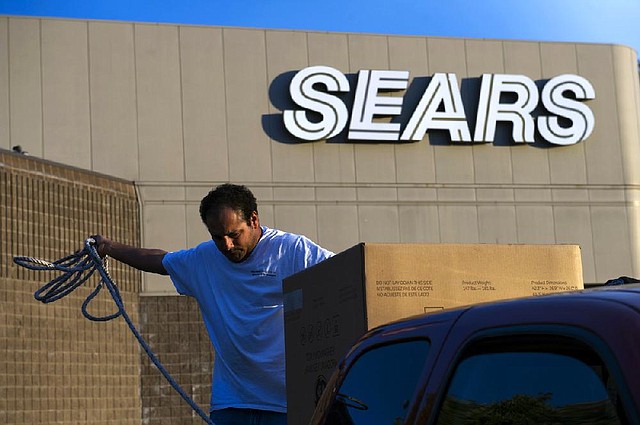Sears cash burn saps sell-off plan
At current rate, retailer to exhaust funds in five months
A customer secures a new washing machine purchased at a Sears Holdings Corp. store in the back of a pickup truck in Richmond, California, U.S., on Tuesday, Feb. 26, 2013. Photographer: David Paul Morris/Bloomberg
Wednesday, May 29, 2013
NEW YORK - Sears Holdings Corp., which reported a quarterly loss more than four times analysts’ estimates last week, will exhaust its cash within five months at its current burn rate, endangering a turnaround plan based on asset sales.
The retailer controlled by hedge-fund manager Edward Lampert had $471 million in cash and equivalents on May 4, its lowest level since 2002.
The accelerating cash burn at Hoffman Estates, Ill .-based Sears, which posted a $279 million loss in its first quarter, puts pressure on the retailer to increase asset sales as it seeks to improve income with a customer rewards program. The parent of Sears and Kmart now has less than half the nine months of cash remaining at J.C. Penney Co., the retailer that last month ousted its chief executive officer and replaced him with his predecessor.
“The Sears story is similar to the J.C. Penney story,” said Jon Sablowsky, the head of trading at Brownstone Investment Group in New York, which trades Sears debt. “You have a mediocre retailer which is fortunate to own a lot of real estate. But if they sell all the assets and aren’t able to turn the business around, that’s when the music stops.”
Sears used up $773 million of cash in the last three months, the most for a first quarter since at least 1995, bringing its deficit to $1.32 billion over the past year. That’s about $200 million wider than J.C. Penney’s shortfall and makes Sears the U.S. department store closest to exhausting its cash.
Chris Brathwaite, a Sears spokesman, declined to comment on the company’s cash balance and bond-market performance.
Sears has sold stores and spun off smaller-format locations and a portion of Sears Canada since the start of last year as it emphasizes its Shop Your Way loyalty program and online services. Lampert, the billionaire who engineered the merger of Kmart Holding Corp. and Sears, Roebuck & Co. eight years ago, took over as chief executive officer in February with a $1 annual salary.
The rewards program is becoming increasingly important as Sears tries to revive sales, which have declined for 25 straight quarters on a trailing 12-month basis.
More than 60 percent of Sears’ sales now come from Shop Your Way participants, and annual sales-per-member have increased by about 8 percent, Lampert said during a May 23 teleconference to discuss earnings in the company’s first quarter of fiscal 2013 with analysts and investors.
Bondholders are demanding a yield of 6.8 percent to hold Sears’s October 2018 notes, which are secured by second liens on the company’s inventory. That compares with the 6.5 percent average for similar-maturity unsecured debt of U.S. retailers, Bloomberg data show. The October 2018 notes account for most of Sears’ $1.24 billion of bonds.
The company’s first-quarter loss was wider than the $64.5 million loss expected by analysts, as Sears suffered from costs related to store closings and severance expenses. Revenue fell 8.8 percent to $8.45 billion.
Sears is evaluating “strategic alternatives” for its protection agreement business, which offers warranties on products such as appliances, chief financial officer Robert Schriesheim said during a conference call.
Options for the unit, which include a possible sale, joint venture or recapitalization, would create liquidity in excess of the $500 million target, he said.
Lampert and his RBS Partners fund hold about 55 percent of Sears shares, Bloomberg data show.
“Eddie Lampert, as the major shareholder of Sears, sitting on a ton of real estate assets, is not going to let the company go bankrupt because that will destroy Eddie Lampert,” said Howard Davidowitz, the chairman of Davidowitz & Associates Inc., a retail consulting and investment banking firm based in New York. “There is no riskof default anywhere.”
Asset sales are weighing on the company, said James Goldstein, an analyst at researcher Credit Sights Inc. in New York. He cited the spin-off of Sears Hometown & Outlet Stores Inc. last year, a move that raised $346.5 million from a rights offering, and a $100 million cash dividend paid by Hometown.
“At this point, I have a pretty cautious view on the debt,” Goldstein said. “Investors had started to buy into the story that there was some stabilization in the underlying business, but based on the first-quarter results it looks like there is still a lot of heavy lifting to be done.”
Sears has been lacking “a comprehensive turnaround strategy to improve merchandising and improve the stores, and investments on those fronts have been very minimal,” said Ana Lai, an analyst at Standard & Poor’sin New York. “They’ve been focusing on their online program, but it hasn’t really taken off or made a significant impact on the operations.”
The loyalty program may lead the company to reduce advertising, curbing traffic from the 40 percent of its customers that aren’t members, Hale Holden, Jonathan Kahnowitz and Jamie Robins of Barclays wrote in a May 24 note.
Discount chain Kmart acquired Sears Roebuck in 2005 in a $12.3 billion takeover Lampert said would create a company with the geographic reach and scale to compete with Wal-Mart Stores. Sears’ brands range from appliance names such as DieHard and Kenmore to apparel-maker Land’s End.
Sears has closed 110 stores since last year, Brathwaite said in an e-mail, and the retailer has $7 billion of assets that can be converted into cash in the near term.
Information for this article was contributed by Charles Mead and Lauren Coleman-Lochner of Bloomberg News.
Business, Pages 23 on 05/29/2013
